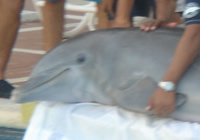You're really just a six and a half
I want this shirt.Update: Many thanks to the person who sent it to me. It's darling! (But do tell me who you are.)
SMART needs you
Oregon SMART (Start Making A Reader Today) still needs a lot of volunteers, and who better to promote literacy than the blogging community? It only takes an hour per week, and periodically you get cookies, punch, and hand-drawn holiday cards. Plus all of the warm fuzzy benefits of helping little kids learn to read. There are probably lots of openings at that school a few blocks from your home or work. (Unless you're super-rich, in which case, you might have to drive to the other side of the tracks.) SMART starts the week of October 11.Pink Martini's second album
Is finally coming out October 19. Details at Pink Martini's site, and the title track, "Hang on Little Tomato" is at about the 14-minute mark of this Sounds Eclectic show. We little tomatoes have been hanging on for seven years for this album. (Embarrassing confession: I had to double-check the spelling of the plural of "tomato." You'd think I was an erstwhile vice president. See what a negative influence certain political leaders have had on the education of the children of America?)Ambiguous search queries
Someone ended up at my site from searching "resume c microsoft or amazon female." Was he looking for a potential employee or warrior girlfriend?Creepy Google Local possibilities
Sure, Google Local is meant for finding, say, your neighborhood wi-fi coffeeshops. But it's far more interesting to find all of the other people in your city who share your somewhat rare name. Apparently there are a few dozen Moiras in Portland, some of whom work/live in my neighborhood. (Only one vague reference to me appears buried in the results.) The service appears to connect people/places through phone number. A public-information number appears for my employer, and clicking the "more" link reveals pages connected to that number, not to me. Not particularly useful in that sense, but the map of all of the Moiras is nifty.Social concern and, uh, consumerism
The poor rat's ass! No one gives it! No wonder there are all those big rat-ass sales after Christmas.says Mimi.
Attentional capacity for classical music
In the "Fun" chapter of Emotional Design, Don Norman talks about the ability of a good design to be perceived and interpreted differently over time, rather than becoming passť like last week's orange low-rise jeans. He discusses "well designed" classical music:I believe [classical music's] longevity derives from the richness and complexity of its structure. The music interleaves multiple themes and variations, some simultaneous, some sequential. Human conscious attention is limited by what it can attend to at any moment, which means that consciousness is restricted to a limited subset of the musical relationships. As a result, each new listening focuses upon a different aspect of the music.
Visual thesaurus
Perhaps one of the best visualization tools for word nerds ever: Visual Thesaurus. So you have your expected tree structure, showing branches of similarity between words. But the tree has this squiggly, organic flow to it making it rather addictive. Words gradually spring, tendril-like at the outermost tips, and the whole thing rotates and bobs like that volleyball Tom Hanks was obsessed with as it went out to sea. (Or, perhaps it rotates and bobs like my metaphors in this entry.)
I wasn't kidding about the dolphins
Apparently some of you don't believe me about the dolphins. Here's a video of the handlers putting one in the hotel pool. Higher-res photos coming soon.Take that, hurricane!
I'm back from Mexico, with tan lines, mosquito bites, and a newfound appreciation for dry clothing. Hurrican Ivan precluded our last four dives, but otherwise the reef time was outstanding. I swam with a shark, a 7' eel, some barracuda, and gazillions of fish. Oh, and across the street from our hotel was one of those exploitative aquariums that corrals dolphins so tourists can swim with them. We sneered at it every time we walked by. However, apparently their tanks aren't hurricane proof, so they carted the animals over to our hotel pool for safe harbor during the storm. Yes, we had 12 DOLPHINS IN THE HOTEL POOL. Beat that. Pictures and stories to resume here shortly.Thanks to Alan for guest hosting while I was gone.
My New Blog
Moira is likely still in Mexico, as I read in the paper that the Cozumel airport is closed. So I guess this space is still mine. I've never been through a Category Five, but I can tell you about the two direct hits I got when I lived on North Carolina's coast: they were scary. I'm guessing they'd be even scarier when you're in another country. After worrying about Moira, next I get to think of my in-laws in Panama City and my family in the beautiful, but below sea-level city of New Orleans.Wallpaper for the Soul
Type in some text, add a random image from google, play with fonts, and voila: you have a typoPoster. What the funk is a typoposter? It's something made by a typogenerator, natch.Moira has strictly forbidden my use of images on her well-designed site. But check out the gallery. And look at the unofficial Considered Design typoposter I made, with only a knowledge of typing.
suck
Recently I received a postcard from my mortgage lender. The woman who was our broker seven years ago had died. They will miss her, but if I might ever need a loan . . .Tacky and insensitive.
And I'm sure you know about Web Pages That Suck. They pointed me to this lovely banner ad: wills.com
Web Development Toolbar for Mozilla
One of the best things about Mozilla products is the ability to add extensions that customize your Internet experience. If you do any webpage design and work with Mozilla or Firefox, I recommend this toolbar. It's a quick download, and once enabled, it lets you do cool things like view a site's css or add your own stylesheet to an existing page. Its powers include revealing your passwords, outlining images, or showing their paths. You can even click on the toolbar and validate your html or css. It's teaching me a lot about how pages work.CSS=CASH
According to one of the posts that appeared in my RSS reader, Westciv is holding a template design competition with cash prizes. I have not used Style Master, but it looks like an amazing product.Zeldman says, "So. Designers. This is not your ordinary 'design a template' contest, but a chance to get your work seen by hundreds of thousands and to associate with people who have helped improve the web (and are still at it)."
If You Want My Business, Make Your Website Mozilla-Friendly
When I visit a website and it doesn't work with my Mozilla Firefox browser, I often leave. Moira and I are both proponents of testing your site to make sure it works in multiple browsers.I am guilty of not giving a ding dong when my own site screws up Internet Explorer. I figure everyone else should switch to Firefox.
Most recent offenders include United Airlines and Freeipods.com. If you are a regular reader of my blog, you'll remember that I almost missed a flight because of United's crappy website. Now I tried to sign up for a flight notification, and that didn't work with Firefox either. Blank Screen. How much did United pay for that?
She Must Know
Thanks, Moira, for letting me post here while you're off having fun. I see that I can generate new posts, but for some reason, the change settings option is disabled. You must have known . . .Let me say first that Moira is my blogmother, despite my ten additional years of time on this earth. She first told me about the whole weblog thing in 2001, and I've been doing it ever since. Sadly, my design skills are lacking, so I try to just steal code (and ideas) from Moira and others.
Lately I've been working on cascading style sheets, another concept I learned from Moira. I'm using it on a poetry site I'm developing. I am incapable of seeing color properly, though I don't know if I'm truly colorblind. So, the poet selected the colors based on an oriental rug in her home.
Moira suggests a photo of some sort to accompany the design, but the poet doesn't want anything too "poetic." Perhaps I'll choose a portrait or something else in keeping with the Art Deco look we started.
Introducing your guest host, Alan
I'm off to Seattle for the weekend and then to Mexico for a week of scuba diving and the arrant laziness only an international beach can evoke. Alan has kindly agreed to post a few tidbits here in the meantime. Maybe some of his popularity will rub off, although we've agreed to a moratorium on the thread that seems to draw the most readers to his site. We here at Considered Design only make fun of those able to defend themselves in properly-punctuated sentences. So, Alan, I've handed you the keys. Please don't enable comments while I'm away. Or spill anything.Designing for needs, not emotions
Enough with the political frippery; it's time to return to some intelligent discussion on HCI and usability. Apologies to my four readers: I know you really only care about the International Cat Agility Tournament. We will return to the kitties shortly.
In the meantime, I'd like to point out an article in this month's Interactions magazine that describes a somewhat realistic method for "designing for emotions," the latest HCI meme. I should mention that this issue of Interactions focuses on "fun," reflecting the trend in the usability community to include desirability/emotion as a tested factor. (See, for example, Don, Peter, George, or Jeff.) Creating a product that people feel passionate about (iPod, eBay, Coca Cola--pesky addiction issue notwithstanding) may make it easier for them to use. At least more willing to explore options and forgive design flaws. But how do you measure desirability or emotional impact of a product? Marketers have been doing this fuzzily for years, but usability folks need some tangible way to connect emotions to ease of use.
Marc Hassenzahl proposes that emotion is strongly contextual (you may love a product under some circumstances but hate it in others), and a thorough needs analysis is the best way to develop that product love. He categorizes four kinds of needs: goal-achievement, personal growth, self-expression, and memory evocation. Traditionally, only the first is tested by usability designers. But fulfilling all of them in a given situation is what leads people to desire a product.
Take my new camera. Can I accomplish my goals? Check. It's ready to shoot in less than a second, fits discreetly in my pocket, and requires minimal fussing. Personal growth? The first time I successfully left the shutter open longer to get a night shot, I was thrilled that it worked. Never tried that before. Now I'm ready to explore some of those other settings on the Mode menu. Self-expression? Damn, but is it stylish. I get a little thrill when friends coo over its size and ask to hold it. Hassenzahl doesn't clearly explain what he means by "evocation" (of memories), but my camera brings up warm fuzzies for my friend Jeff, who had a similar tiny camera, and I supposed I'm making new memories as I travel with mine. That it fulfills each of these needs makes me forgive my camera's flaws, which include my having to anchor my elbow on a surface before taking a shot to ensure that it's not blurry (darn thing's too small to hold still), and that there's not a protective cover for the LCD.
Overall, Hassenzahl provides a somewhat more tangible method for capturing that elusive product love through needs analysis. Let's see if it works.



Comments
Post a Comment Hide Comments